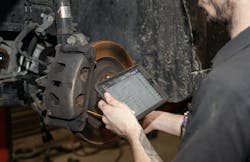SHOP STATS: Bove's Auto Repair Location: Rockford, Ill. Operator: Tony Bove Average Monthly Car Count: 446 Staff Size: 13 Shop Size: 7,000 sq. ft. Annual Revenue: $2.4 million
What’s the difference between using a digital inspection tool versus not? Almost double the ARO, that’s what.
When Tony Bove, owner of Bove’s Auto Repair in Rockford, Ill., decided to have his technicians utilize digital inspections in the shop, his ARO went from $287 to $440, a substantial difference. But it wasn’t an overnight success. The problem? Few technicians completed the digital inspections on each and every service, which meant Bove was missing out on money-making opportunities each time the inspection wasn’t completed.
So, what did he do to curb the problem? He put processes in place to make sure it was done on every vehicle that came through the shop’s doors.
The Backstory
What used to be a one-building operation back when the shop opened in 1963 has grown into three—a quick lube, a space for small repairs, and another auto repair building where the bigger jobs are carried out. With these three different spaces to run, efficiency is essential for the operation to run smoothly.
After seeing another shop owner’s digital inspection platform and how it led to upsells from just a couple of pictures, he wanted to try it out for himself. The shop is a NAPA Gold Certified Auto Care Center, so AutoVitals was offered to the shop free of charge to try out its digital inspections.
“After since seeing [the digital inspections] in action, I ordered the iPads from AutoVitals and have been hooked ever since,” Bove says.
When the system first came on board in the shop in 2017, learning was all trial and error. The digital-savvy, millennial techs picked up on it really fast, but the older techs weren’t keen on the new process.
The Problem
For the first six to eight months of using digital inspections on in the shop, Bove noticed a huge increase in the shop’s ARO, but he also noticed the processes for performing the inspections weren’t efficient or consistent.
For one, the technicians would wait to run the digital inspection until after completing the initial repair that the customer came in for, which led to them to have to go back and redo or perform additional repairs if the inspection found more issues rather than presenting all of the work to the customer up front, which created a lot of back and forth and wasn’t the most efficient use of time.
“There’s nothing worse than trying to get a job in and waiting for parts or waiting for jobs,” Bove says. “We’ve learned over the years that it doesn’t work to do it at the end.”
Along with this, technicians didn’t perform the inspection on a regular basis. Bove believes part of the problem is laziness and complacency, but also the technicians’ mindsets. The technicians didn’t get paid to do the inspections, so they wanted to skip a part of the process; they wanted results now, not later, explains Bove.
“I think it’s very common after a while, because if you don’t have the right things in place to do it every time, everyone gets complacent,” Bove says. “If you let them get away with it a few times, it won’t stop.”
The Solution
When Bove started seeing more profit from using the digital inspections, he decided to make digital inspections mandatory and created a system to ensure it’s done consistently and as efficiently as possible. To avoid the hassle of technicians having to start all over after finding additional work, Bove required the digital inspection to be done first in order to come up with a complete diagnosis from the start; there was no way around it. To ensure his technicians weren’t trying to skip forward to the repair, Bove created a technical rule in his diagnostic system that doesn’t allow a technician to move forward until the digital inspection is approved by a service advisor. With the technical feature, there’s no way for technicians to start doing the work that the vehicle was brought in for until a complete inspection has been performed and all work on the vehicle has been identified.
With the digital inspection, technicians are required to take at least 10 pictures, including parts of the vehicle that don’t need to be fixed at the time. This way, the shop’s customers can compare pictures when they come back in and can physically see parts getting worse over time.
“It’s easier to communicate with the customer,” Bove says. “We can show them exactly what we are looking at; it’s like they are right next to [the technician].”
And once the customer sees this proof, they then trust the technician’s judgement and are more likely to get the recommended repairs.
So, yes, physically a technician can’t complete a job unless they run the inspection, but Bove didn’t want to force technicians into it, he wanted them to want to complete the inspections. Bove, seeing the payoff, shares the numbers with his team in the morning shop meetings, which helped the team see the impact of performing the inspections and helped create buy-in.
The Aftermath
The shop’s nearly-double ARO gave Bove’s technicians a push to do digital inspections every time. Once Bove’s team started to see the physical numbers and how much more money they could be making, they all bought in—old and new techs alike.
“I showed them they could be making more money for doing this,” Bove says. “You have to have some sort of benefit attached to it.”
Now, after transferring to an all-digital platform, the techs complete the inspection each and every service. Yes, the process is enforced, but the monetary incentive behind it has given technicians a huge push toward wanting to use the platform.
And, to be even more efficient with their time, techs are now running the digital inspection at the beginning of the service to diagnose issues that the customer is not aware of, which helps drive up ARO. With their new process, they have at least three cars lined up at a time for repairs, so once one 10-minute inspection is complete, the technicians can work on that vehicle’s estimate while running a digital inspection on another vehicle in the meantime.
“It was a little hard to get used to doing the digital inspections in the beginning, but once they saw the results, as far as more money on their checks, it got a lot easier,” Bove says.
The Takeaway
With the bad reputation that can revolve around technicians, the digital inspection instills more trust in them. It not only ensures the technician is finding every repair issue, but it also provides proof for the customer, which helps reverse the negative stigma that the industry has. The more it’s done, the more trust that’s involved, the more repairs the customer is willing to get done, and the more money that will go into the technician’s—and auto repair shop’s—pocket. So, essentially, if your techs aren’t running the inspection each and every time, you’re losing easy money.
“Business is about trust, and if they trust you, they will trust you to fix their car,” Bove says. “Pictures sell 1,000 words.”

